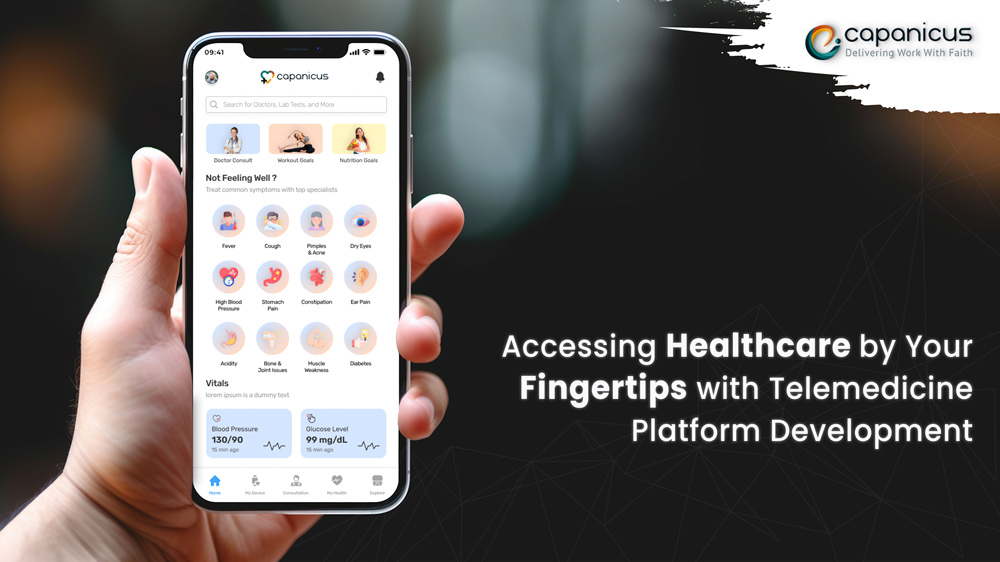What is a telemedicine platform?
A telemedicine platform is an online platform or software enabling healthcare professionals to provide medical services remotely to patients using technology such as video calls, chat messaging, and other communication tools. It facilitates virtual consultations, diagnoses, treatment plans, and even prescription services without needing an in-person visit to a healthcare facility. With a telemedicine platform, patients can access healthcare services conveniently from their homes or any location with an internet connection.
These platforms have become increasingly popular, especially in recent years, as they offer a range of benefits such as accessibility, cost-effectiveness, and the ability to overcome geographical barriers. It allows doctors and healthcare providers to reach and assist patients who may be located in remote areas or cannot visit a physical clinic for various reasons. Additionally, telemedicine platform development has played a vital role in improving healthcare access during emergencies, reducing waiting times, and enhancing overall patient satisfaction. The development and utilization of such platforms have significantly transformed the healthcare landscape, making healthcare services more accessible, efficient, and patient-centric.
Key Features and Functionality of Telemedicine Apps
Telemedicine apps are specifically designed to facilitate remote medical consultations and provide healthcare services through digital platforms. The key features and functionality of telemedicine apps include:
- Virtual Consultations: Apps enable users to connect with healthcare professionals remotely, allowing for real-time video or audio consultations. Users can discuss symptoms, receive medical advice, and even get prescriptions through these virtual visits.
- Appointment Scheduling: Patients can easily book virtual appointments with doctors, specialists, or other healthcare providers through the app. It provides flexibility and convenience in managing appointments according to the user’s availability.
- Patient Medical History: The application stores patient medical records and history securely within the platform. This feature allows doctors to access the patient’s medical information during consultations, making it easier to provide accurate diagnoses and treatments.
- Messaging and Chat: Users can communicate with healthcare providers through secure messaging and chat functionalities within the app. Patients can ask questions, discuss symptoms, and receive follow-up instructions from their healthcare professionals.
- Prescription Management: It allows doctors to electronically send prescriptions directly to a preferred pharmacy, saving patients time and effort. Users can also access their prescription history and medication reminders through the app.
- Remote Monitoring: Some telemedicine apps integrate with wearable devices or sensors to enable the remote monitoring of vital signs or health parameters. Doctors can track the patient’s health condition and provide necessary interventions accordingly.
- AI-Powered Symptom Checkers: AI-driven chatbots or symptom checkers can assist users in evaluating their symptoms and provide initial guidance on potential conditions or necessary actions before scheduling a consultation.
- Secure Data Exchange: Ensuring the privacy and security of sensitive medical information is crucial. These apps employ encryption and compliance measures to secure patient data during transmission and storage, following industry regulations and guidelines.
- Integration with Electronic Health Records (EHR): Integration with EHR systems allows seamless sharing of patient data between healthcare providers, enhancing continuity of care and reducing redundant procedures or tests.
- On-Demand Healthcare Resources: These apps may offer access to a wide range of healthcare resources, including educational materials, articles, and reliable health information, empowering users to make informed decisions about their health.
These features collectively aim to improve access to healthcare, reduce unnecessary physical visits, and provide efficient medical services remotely through the convenience of a mobile or web-based application.
Developing a Telemedicine App: Key Considerations
To ensure a successful and effective conclusion, developing a telemedicine platform requires several well-defined procedures and considerations. The following lists the essential factors that app developers should be aware of when developing telemedicine apps.
Determining the Target Population and Their Unique Medical Requirements
Understanding the target audience’s unique healthcare demands is essential before starting to design telemedicine apps. To make sure the app efficiently serves the intended users, this information will inform its design, features, and functionalities. The demographics, health conditions, and geographic location of the target population might all change. A telehealth application intended for senior citizens, for instance, could need to have an easy-to-use interface with big letter sizes and simple navigation.
The Appropriate Technology Stack Selection
For telemedicine software development to be reliable and scalable, selecting the appropriate technological stack is crucial. The databases, libraries, frameworks, and programming languages that make up the app’s architecture are all included in the technology stack. Important factors to take into account are the intended features of the app, the need for scalability, and compatibility with other platforms (such as iOS and Android).
Databases like MySQL or MongoDB, frameworks like React Native or Flutter, and programming languages like JavaScript or Swift are frequently utilized in the development of telehealth software. To make sure that the technology stack is in line with the objectives of the app and can be scaled in the long run, it is imperative to confer with a development team or skilled engineers.
Taking Care of Security and Privacy Issues
Since patient data is extremely sensitive and governed by stringent rules, security, and privacy are critical considerations in the creation of healthcare apps. Respecting laws like the Health Insurance Portability and Accountability Act (HIPAA) is essential if one wants to forbid unauthorized third parties from gaining access to electronic health information (EHRs). Strong security features, such as data encryption, safe user authentication, and secure data transmission, should be included in the app. Ensuring the app’s security and safeguarding patient privacy can be achieved by implementing industry-standard security methods and collaborating with hosting providers that comply with HIPAA regulations.
Harmonious Coordination with Current Healthcare Systems
Integration with current healthcare systems must be done seamlessly to improve telemedicine’s efficacy and efficiency. Healthcare professionals can obtain a patient’s whole medical history through integration with EHRs, which facilitates more informed diagnosis and treatment choices.
The healthcare application ought to possess the ability to safely obtain and modify patient data from electronic health record platforms, guaranteeing uninterrupted medical attention and diminishing needless data entry. Integration with current healthcare systems can be made easier by working with EHR suppliers or by using standardized interoperability protocols like FHIR or HL7.
Overcoming Challenges in Telemedicine Adoption
Telemedicine, the provision of healthcare services remotely through technology, has seen remarkable growth in recent years. However, its widespread adoption still faces several challenges. One of the primary hurdles is the resistance to change from both healthcare providers and patients. Many healthcare professionals are accustomed to traditional in-person consultations and may be hesitant to embrace new technologies. Similarly, patients may have reservations about the reliability and effectiveness of telemedicine compared to face-to-face visits.
Another significant challenge is the limited access to technology and internet connectivity, especially in remote or underprivileged areas. For telemedicine to reach its full potential, a reliable internet connection and access to appropriate devices are essential. Unfortunately, such infrastructure may be lacking in some regions, hindering the adoption of telemedicine.
Data privacy and security concerns also present challenges in telemedicine adoption. As patient information is transmitted electronically, there is a risk of data breaches and privacy violations. Ensuring robust security measures and complying with stringent data protection regulations are essential to gaining trust from both healthcare providers and patients.
Moreover, the reimbursement policies of healthcare systems often lag behind technological advancements. In many cases, telemedicine services are not adequately reimbursed compared to traditional in-person visits. This financial barrier can discourage healthcare providers from investing in telemedicine infrastructure and limit patient access to these services.
Future Directions and Innovations in Telemedicine Apps
In the rapidly evolving field of healthcare, several future directions and innovations hold great promise for enhancing healthcare access and delivery. Telehealth apps, specifically, are at the forefront of these advancements. Hire the team of Capanicus, who understands the importance of staying on top of these trends and provide users with the most comprehensive and up-to-date information.
One major direction in telemedicine app development is the integration of artificial intelligence (AI) and machine learning algorithms. These technologies can assist in the accurate diagnosis and treatment recommendation process by analyzing vast amounts of patient data and medical literature. This can leverage these capabilities to provide users with personalized and evidence-based responses to their health-related queries.
Furthermore, there is a growing focus on remote patient monitoring through healthcare apps. With the advancement of wearable devices and Internet of Things (IoT) technology, patients can now monitor their vital signs and health parameters from the comfort of their homes. This application can guide users in selecting appropriate wearable devices, interpreting collected data, and recommending necessary actions based on the results.
Another exciting innovation in telemedicine apps is the inclusion of virtual reality (VR) and augmented reality (AR) features. These immersive technologies have the potential to revolutionize medical education, surgical procedures, and even mental health treatments. By incorporating VR and AR capabilities, users can gain access to interactive and immersive medical content, enhancing their learning and understanding of complex medical concepts.
One crucial aspect of telemedicine app development is that it ensures secure and private communication between patients and healthcare providers. With the increasing use of telemedicine for sensitive medical consultations and information exchange, robust encryption and authentication protocols are paramount. Telemedicine places a strong emphasis on user privacy and data security, providing a safe platform for users to engage in telemedicine consultations.
In conclusion, telemedicine apps represent a significant leap forward in healthcare innovation. By leveraging AI and machine learning, facilitating remote patient monitoring, embracing VR and AR technologies, and prioritizing user privacy and data security, it aims to provide users with a comprehensive and exceptional experience.
Conclusion
Thus, telemedicine app development is permanently changing the way that healthcare is delivered. Here are the main reasons:
-Eliminate the need to wait weeks for a prompt consultation or follow-up.
-No more missing work or classes to wait in a waiting area.
You can now get healthcare on-demand and easily at your convenience!
Patients can now more than ever take charge of their health and wellness thanks to these cutting-edge apps. Although it won’t ever completely replace in-person treatment, telemedicine offers a practical substitute for necessities. Getting access to high-quality healthcare will soon be as simple as ordering takeaway or grabbing a rideshare. Apps for telemedicine are genuinely improving healthcare.



